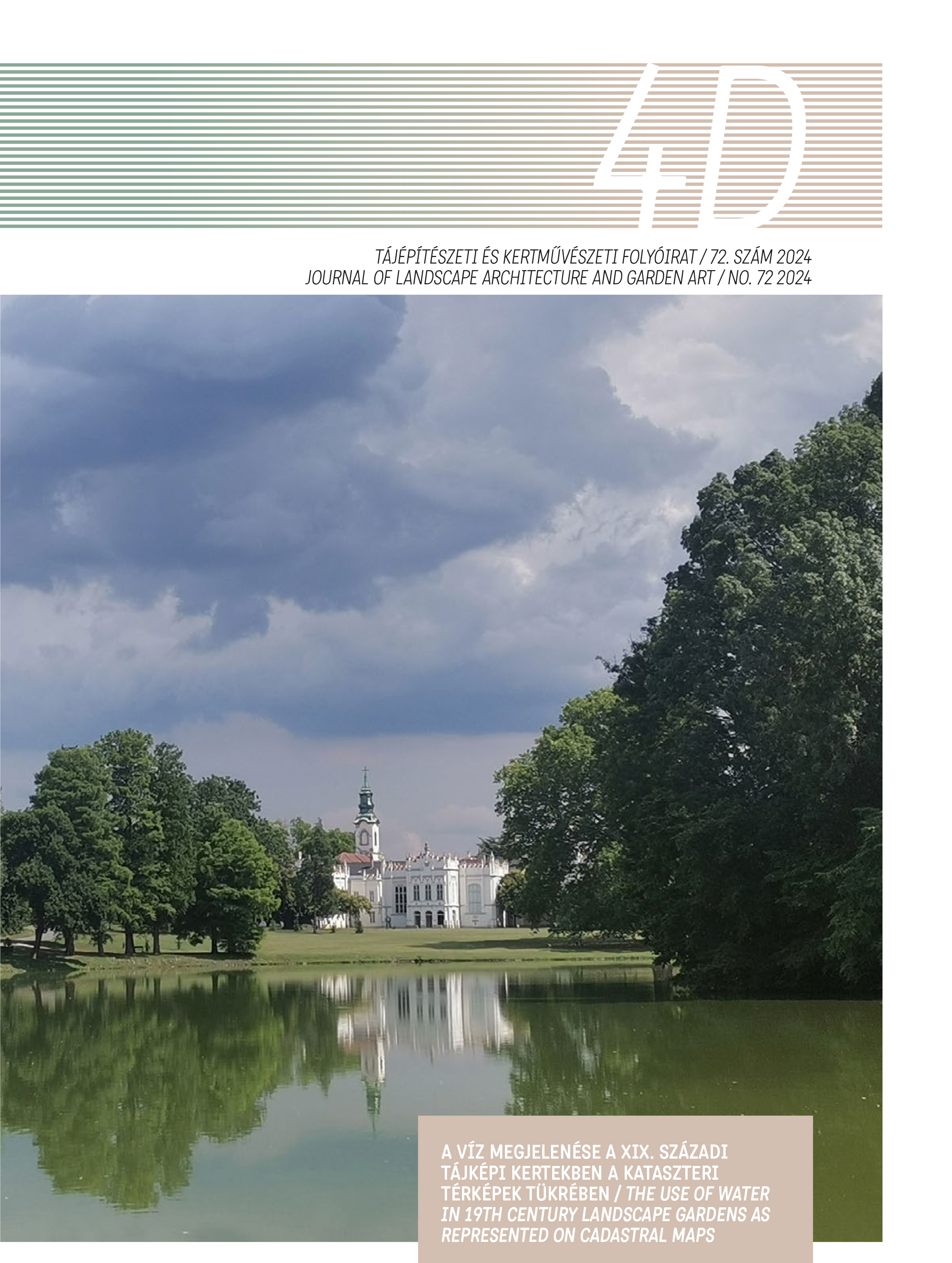What does the Internet tell us about green spaces?
The virtual communication about three Budapest public park projects and its potential in green infrastructure protection
DOI:
https://doi.org/10.36249/4d.72.5379Keywords:
open space development, content analysis, communication, climate change adaptation, visibilityAbstract
The study explores the online communication regarding three Budapest public parks opened in 2022, investigating what type of information is available about them to a wide audience and how vital ecological processes and living park elements are represented. Applying the methodof content analysis, the selected texts from primary (online platforms related to client, designer, or contractor) and secondary (interviews with designers, professionalpraises) sources were coded. The ten main code groups give an overview of the major fields and components of green space development projects. Each field appears in a different degree of importance, but the proportion of Design aspectscodes is similar for the three projects. Sustainability is mentioned in all three, suggesting that it is a key factor in the positive public perception of the project. However, the depth with which this is discussed varies, being merely an empty token in certain contexts. In the case of one project, there was regular communication about the project implementation on behalf of the creators. This is the same project that gives the most detailed information about living park elements and the ecological processes taking place between them. It is concluded that the conscious and responsible online communication about public green space projects has the potential to raise awareness by increasing the knowledge about and visibility of the essential ecosystem services provided by parks and green infrastructure in general, thereby contributing to their long-term protection.
References
Aczél, P., & Veszelszki, Á. (2018). Egy új tudománykommunikációs modell szükségességéről. A scixcom-modell. JEL-KÉP, 2018(4), 5–18. https://doi.org/10.20520/JEL-KEP.2018.4.5
Ahern, J. (2011). From fail-safe to safe-to-fail: Sustainability and resilience in the new urban world. Landscape and Urban Planning, 100(4), 341–343. https://doi.org/10.1016/j.landurbplan.2011.02.021
Ahern, J. (2013). Urban landscape sustainability and resilience: The promise and challenges of integrating ecology with urban planning and design. Landscape Ecology, 28(6), 1203–1212. https://doi.org/10.1007/s10980-012-9799-z
Bardóczi, S. (2012). Az Év Tájépítésze Díj margójára = To the margin of the Landscape Architect of the Year Award. 4D Tájépítészeti és Kertművészeti Folyóirat, 26, 28–31.
Benson, J. F., & Roe, M. H. (Eds.). (2007). Landscape and sustainability (2nd ed). Routledge.
Buzási, A., & Szalmáné Csete, M. (2018). Fenntartható fejlődés és klímaváltozás – globális összefüggések lokális értelmezése. Magyar Tudomány, 1349–1358. https://doi.org/10.1556/2065.179.2018.9.8
Chiesura, A. (2004). The role of urban parks for the sustainable city. Landscape and Urban Planning, 68(1), 129–138. https://doi.org/10.1016/j.landurbplan.2003.08.003
Dancsokné Fóris, E. K. (2020). Vidéki térségek a települések szövetében [Disszertáció, Szent István Egyetem. Tájépítészeti és Tájökológiai Doktori Iskola]. https://doi.org/10.14751/SZIE.2020.072
Fekete A., Gecséné Tar I., Sárospataki M., & Győri P. (2020). Educational role of public parks. Windows to past, to future and to exotic worlds = Közparkok oktatási szerepe. Ablakok múltra, jelenre, távoli világokra. 4D TÁJÉPÍTÉSZETI ÉS KERTMŰVÉSZETI FOLYÓIRAT, 55–56, pp. 38-53.
Géring, Z. (2014). Tartalomelemzés: a virtuális és a ’valós’ világ határán. Egy vállalati honlap-elemzés bemutatása. Kultúra és Közösség, 5(1), 9–24.
Meyer, E. K. (2008). Sustaining beauty. The performance of appearance: A manifesto in three parts. Journal of Landscape Architecture, 3(1), 6–23. https://doi.org/10.1080/18626033.2008.9723392
M. Szilágyi, K., & Vaszócsik, V. (2022). Zöldfelületi rendszer, zöldinfrastruktúra • Urban Green System and Green Infrastructure. Magyar Tudomány. https://doi.org/10.1556/2065.183.2022.9.4
Ormos, I. (2000 [1967]). A kerttervezés története és gyakorlata (Második, átdolgozott kiadás reprint kiadása). Mezőgazdasági Kiadó.
Roe, M. H. (2007). Landscape and sustainability: An overview. In J. F. Benson & M. H. Roe (Eds.), Landscape and sustainability (2nd ed, pp. 1–15). Routledge.
Stuart-Murray, J. (2007). The practice of sustainable landscape architecture. In J. F. Benson & M. H. Roe (Eds.), Landscape and sustainability (2nd ed, pp. 222–236). Routledge.
Szabó, Á. (2012). A városok fenntarthatóságának egyes szempontjai. In I. Körmendy (Ed.), Élhető települési táj: Településépítészeti tanulmányok (pp. 91–105). Budapesti Corvinus Egyetem.
Szabó, Á. (2023). „FENNTARTHATÓ ÉS ÉLHETŐ VÁROS”. Budapesti Műszaki és Gazdaságtudományi Egyetem Építészmérnöki Kar Urbanisztika Tanszék. https://tudastar.epitesz.bme.hu/wp-content/uploads/2024/02/Fenntarthato_elheto_OK.pdf (Accessed: 2024.03.02.)
Szabó, Patrícia (2023) New Public Green Spaces: Tools of Climate Protection or Greenwashed? In: Till, Anilla & Kovács-Magosi, Orsolya (eds.) (2023): Book of Abstracts. Corvinus Communication Conferences (CoCoCo). Melting Ice, Hot Topics: Conference on Sustainability Communication for Young Researchers. Corvinus University of Budapest.
Tatai, Z., Szőke, B., M. Szilágyi, K., B. Nagy, I. R., Jombach, S., & Kollányi, L. (2017). Budapest zöldfelületi rendszerének fejlesztési koncepciója. Budapest zöldinfrastruktúra koncepciója. II. kötet: Koncepció. BFVT - Budapest Főváros Városépítési Tervező Kft. https://archiv.budapest.hu/Documents/V%C3%A1ros%C3% A9p%C3%ADt%C3%A9si%20F%C5%91oszt%C3%A1ly/II.%20k%C3%B6tet%20-%20Koncepci%C3%B3.pdf (Accessed: 2024-01-29)
Thompson, I. (2000). Ecology, Community and Delight: An Inquiry into Values in Landscape Architecture. Taylor and Francis.
Thompson, I. H. (2002). Ecology, community and delight: A trivalent approach to landscape education. Landscape and Urban Planning, 60(2), 81–93. Scopus. https://doi.org/10.1016/S0169-2046(02)00061-0
Till, Anilla & Kovács-Magosi, Orsolya (eds.) (2023): Book of Abstracts. Corvinus Communication Conferences (CoCoCo). Melting Ice, Hot Topics: Conference on Sustainability Communication for Young Researchers. Corvinus University of Budapest.
Wilkin, D. C. (1996). Accounting for sustainability: Challenges to landscape professionals in an increasingly unsustainable world. Landscape and Urban Planning, 36, 217–227.
Radó Dezső Terv. Available online: https://archiv.budapest.hu/Documents/Rado_Dezso_Terv_2021.pdf (Accessed: 2024.04.10.)
AngyalZÖLD 3.0. Available online: https://kozszolgaltato.bp13.hu/tevekenysegeink/kozteruletek/angyalzold/ (Accessed: 2024.04.10.)
Tájépítészeti Nívódíj. Hungarian Association of Landscape Architects: https://tajepiteszek.hu/tn [Accessed: 2023.02.02.]
Downloads
Published
Issue
Section
License
Copyright (c) 2024 Szabó Patrícia, Sárospataki Máté

This work is licensed under a Creative Commons Attribution-NonCommercial-NoDerivatives 4.0 International License.
A folyóirat Open Access (Gold). Cikkeire a Creative Commons 4.0 standard licenc alábbi típusa vonatkozik: CC-BY-NC-ND-4.0. Ennek értelmében a mű szabadon másolható, terjeszthető, bemutatható és előadható, azonban nem használható fel kereskedelmi célokra (NC), továbbá nem módosítható és nem készíthető belőle átdolgozás, származékos mű (ND). A licenc alapján a szerző vagy a jogosult által meghatározott módon fel kell tüntetni a szerző nevét és a szerzői mű címét (BY).



